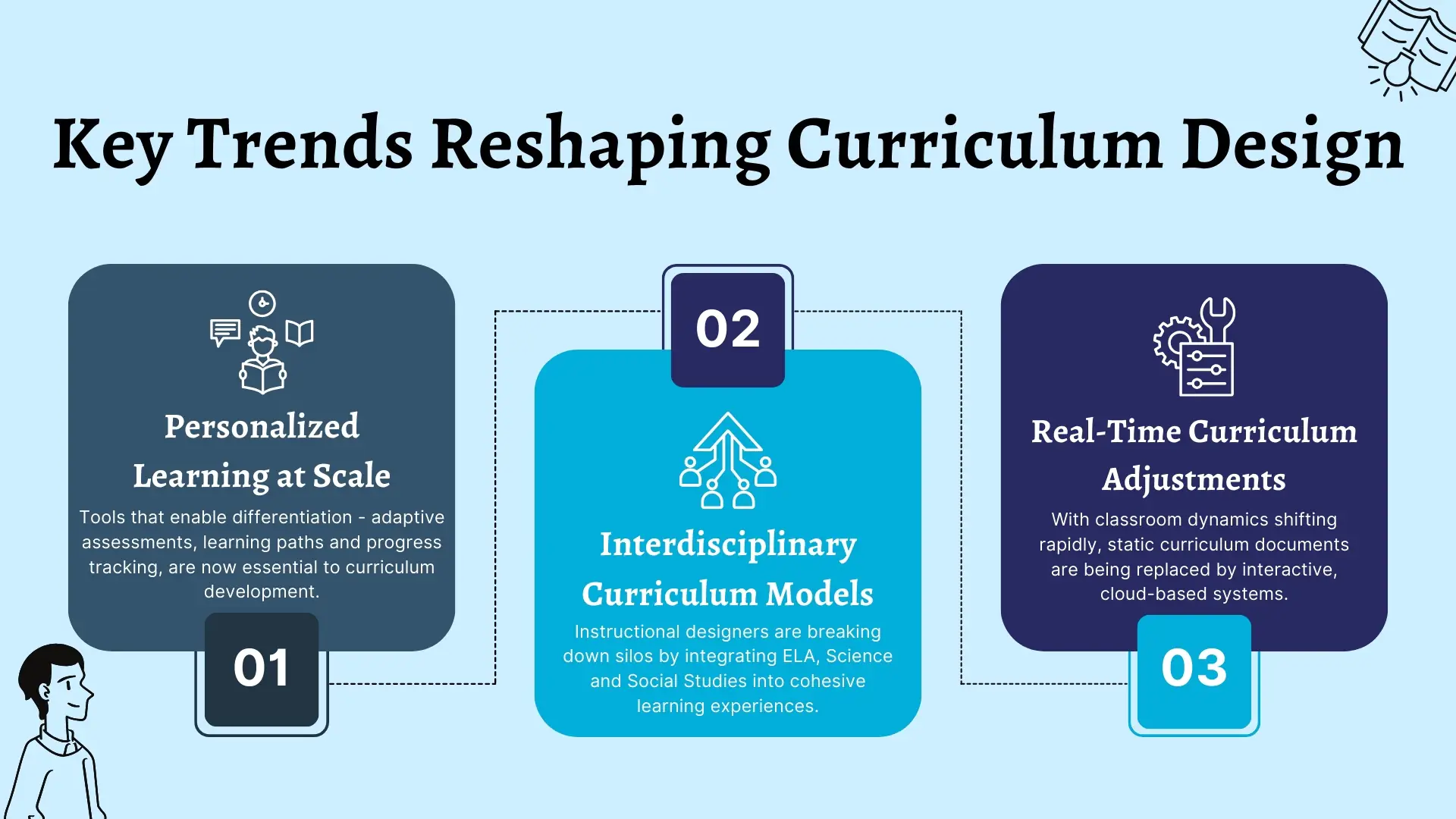Schedule a free demo to learn more
The Future of Curriculum Management: Key Insights for Teachers and Instructional Designers
23rd May 2025

In the past, curriculum design was largely a linear, textbook-driven process. But today, that model is undergoing a radical transformation. The modern K-12 classroom is more dynamic, data-driven and personalized than ever before, and so is the curriculum that powers it.
As we step into 2025 and beyond, the future of curriculum management lies at the intersection of pedagogy and technology. Whether you’re a teacher mapping out standards-aligned lessons or a leader overseeing curriculum across multiple schools, staying in step with emerging trends is critical.
Today’s blog explores the latest developments in curriculum design, how AI and digital tools are changing the game and how platforms like Edusfere are helping educators build future-ready classrooms.
The New Rules of Curriculum Design: What’s Changing?
According to a 2024 report from the Consortium for School Networking (CoSN), 73% of U.S. school districts have shifted toward personalized or blended learning models that require modular, standards-aligned curriculum frameworks.
Curriculum design is no longer about fitting content into pre-made boxes. It’s about flexibility, responsiveness and relevance.
Key trends reshaping Curriculum Design:
1. Personalized learning at scale
Tools that enable differentiation, i.e., adaptive assessments, learning paths, and progress tracking are now essential to curriculum development.
2. Interdisciplinary Curriculum Models
Instructional designers are breaking down silos by integrating ELA, Science and Social Studies into cohesive learning experiences. This cross-pollination is helping students build 21st-century skills.
3. Real-time Curriculum Adjustments
With classroom dynamics shifting quickly, teachers need tools that allow for on-the-go changes. Static curriculum documents are being replaced by interactive, cloud-based systems.
The Role of AI, Personalization & Digital tools in Curriculum Management
According to HolonIQ, the EdTech AI market is projected to grow to $10 billion globally by 2030, with the U.S. being the leading adopter.
In 2025, the conversation is no longer whether technology should be integrated into curriculum design, it’s how deeply it should be embedded.
AI is transforming curriculum management by automating time-consuming tasks and offering powerful insights.
How is AI Empowering Educators?
AI in curriculum management isn’t about replacing teachers. It’s about equipping them with the insights they need to make smarter instructional decisions, but faster.
Curriculum Mapping with AI
Intelligent engines can auto-suggest standards-aligned content, reducing manual mapping time by up to 50%.
Predictive Analytics
AI can analyze student performance data to recommend curriculum modifications that improve outcomes.
Differentiated Instruction Support AI-powered tools can help educators create tailored learning paths based on individual student needs, including Individualized Education Programs (IEPs) and English Language Learners (ELL) adaptations.
Digital Tools and Curriculum Mapping Software for K-12 US schools
Here’s how leading education researcher, Dr. Robert Marzano underlines the significance of Curriculum Mapping tools:
“Effective curriculum management is directly linked to student achievement. Schools that adopt dynamic mapping tools see up to a 16% improvement in student performance within 12 months.”
Click to learn more about Curriculum Mapping
A modern curriculum mapping software does more than digitize curriculum; it becomes the single source of truth for all stakeholders. Here are the key features that top educators often look for:
- Standards alignment (Common Core, NGSS, state-specific)
- Drag-and-drop curriculum planners
- Real-time collaboration between departments
- Curriculum version tracking
- Integration with SIS and LMS platforms
Challenges in today’s Curriculum Ecosystem
According to the 2024 EdWeek Research Center survey, more than 61% of teachers feel their current curriculum tools are not responsive to real-time classroom needs.
Despite the progress in adoption of these tools, many educators continue to face systemic challenges including:
- Fragmented systems: Too many schools use separate tools for lesson planning, curriculum and assessment.
- Lack of real-time data: Without up-to-date insights, decision-makers struggle to iterate curriculum meaningfully.
- Professional Development Gaps: Teachers aren’t always trained on how to use curriculum tools effectively.
This highlights the growing demand for all-in-one curriculum management platforms that integrate AI, mapping, assessment and collaboration in one dashboard.
How Edusfere is Building for the Future of K-12 US Schools
At Edusfere, we believe the future of curriculum design is dynamic, data-informed and deeply collaborative. That’s why we’ve built a platform that helps instructional leaders, teachers and content providers work together seamlessly.
Here’s what sets Edusfere apart:
1. Real-Time Curriculum Mapping Software
Designed to enable documentation to be a natural part of a teacher’s daily workflow instead of extra work, our platform allows educators to design, revise and align curriculum with national and state standards in minutes, not hours.
2. Built-In AI Recommendations
Edusfere’s AI analyzes curriculum plans and recommends updates based on emerging standards, student data and instructional goals.
3. Cross-Team Collaboration
Whether it’s a district-wide rollout or a grade-level team planning weekly lessons, our platform ensures everyone stays aligned.
4. Accreditation-ready Documentation
Do you need to prepare for a visit from AdvancED or your state’s Department of Education? At Edusfere, we help schools stay audit-ready with real-time tracking of curriculum changes, learning goal alignment and compliance.
5. Professional Learning Integration
We don’t just offer a tool, we offer a complete solution with built-in training modules and workshops for educators.

What this really means for School Leaders, Principals and Teachers
If you’re a school or district leader planning ahead, here’s how to take actionable steps toward future-ready Curriculum Management:
For School Leaders
- Audit your current curriculum systems. Are they integrated or siloed?
- Invest in platforms that offer flexibility and real-time updates.
- Promote a culture of collaborative curriculum design.
For Teachers
- Advocate for tools that save time and improve lesson alignment.
- Engage in ongoing PD to stay updated on curriculum technology.
- Use AI insights to personalize instruction without burnout.
For District Leaders
- Standardize curriculum planning across schools for equity and consistency.
- Choose vendors that offer both technical and pedagogical support.
- Measure curriculum impact through data, not just anecdotal success.
Future-proof your Instructional Strategy with Edusfere
Curriculum management is evolving rapidly and the most successful educators will be the ones who embrace a future-forward mindset. With AI-powered tools, dynamic curriculum mapping software and platforms like Edusfere, the path towards more effective, personalized and scalable learning is already being paved.
As education shifts toward agility, equity and evidence-based planning, your curriculum shouldn’t lag behind. Now is the time to future-proof your institution’s instructional strategy.
Ready to transform how your school manages Curriculum?
To explore Edusfere’s innovative AI-powered Curriculum Mapping platform, built for K-12, schedule a Demo Session now!